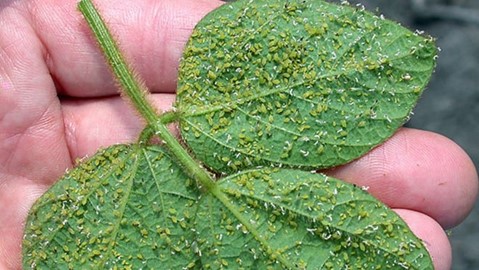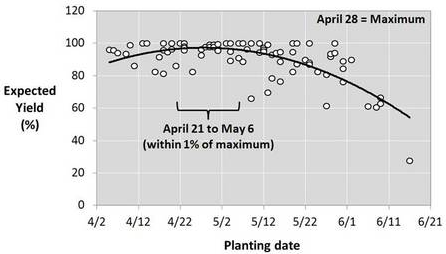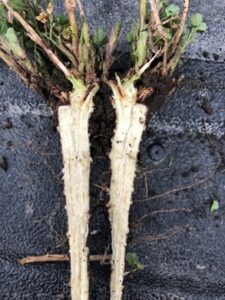
Ag Partners Agronomic Insights
Week of April 15, 2024
Local, professional reports straight from the field, from all regions serviced by Ag Partners.
Meet this week’s featured agronomists:
 Austin Schultz Austin SchultzLe Center |
 Tyrell Treptow Tyrell TreptowGoodhue |
 Brett Decker Brett DeckerLewiston |
 Kirsten Bauer Kirsten BauerEllsworth |
WEST
Belle Plaine – Le Center – Le Sueur – Morristown
Welcome back to our Weekly Agronomy Updates! Who needs Punxsutawney Phil with mild winters like this past one? I think we all can agree that the 23/24’ winter was one of the mildest winters many Minnesotans have experienced in decades and for many younger residents the mildest one they have ever had. While it is enjoyable for many growers who have livestock, it does pose a few challenges going forward into the 2024 growing season. One of the primary challenges I expect to see this summer is a larger increase in our pest populations.

Insects like the soybean aphid (pictured here) have significant population decreases once temperatures fall below -25 degrees Fahrenheit, which we did not see much of last winter. Other pests such as the alfalfa weevil and corn rootworm that can benefit from snow cover for protection did not have that snow cover this year, but also didn’t have an extended period of negative temperatures to irradicate already high populations. Even migratory insects like the potato leafhopper could be seen farther north sooner because they didn’t have to travel as far south to stay alive.
Overall, I think staying vigilant this summer on our pest populations will be very important and following our best management practices will be key to growing a viable crop. Every different scenario we face as growers causes a different challenge for us to face, and being mindful of those differences allows us to succeed.
-Austin
EAST
Goodhue – Lake City – Pine Island – Kenyon
-Tyrell
SOUTH
Elgin – Lewiston – Stewartville
 Welcome to the 2024 planting season. Soil moisture was a major concern for growers after last year and limited snowfall this past winter. As we turned the calendar to April the rain and snow showers have been refreshing by all growers. This past weekend presented some great weather and soil conditions to apply nutrients and do some seedbed preparation, with even quite a few planters rolling in southeast Minnesota. Just as we started in the fields, we are now looking at more precipitation through the middle of this week. Once we get back to the fields let’s be diligent not to rush planting into cold, wet soils. Good seed-to-soil contact is key so the seeds can quickly and evenly absorb moisture for a uniform stand. The most critical time in a corn plant’s life is the first 24-48 hours and the first moisture that is imbibed by the seed. As you can see in the graph pictured here, we generally have the best chance to achieve 100% yield when planted between April 21st and May 6th. By not rushing we still have time to optimize grain yield and achieve the highest economic return.
Welcome to the 2024 planting season. Soil moisture was a major concern for growers after last year and limited snowfall this past winter. As we turned the calendar to April the rain and snow showers have been refreshing by all growers. This past weekend presented some great weather and soil conditions to apply nutrients and do some seedbed preparation, with even quite a few planters rolling in southeast Minnesota. Just as we started in the fields, we are now looking at more precipitation through the middle of this week. Once we get back to the fields let’s be diligent not to rush planting into cold, wet soils. Good seed-to-soil contact is key so the seeds can quickly and evenly absorb moisture for a uniform stand. The most critical time in a corn plant’s life is the first 24-48 hours and the first moisture that is imbibed by the seed. As you can see in the graph pictured here, we generally have the best chance to achieve 100% yield when planted between April 21st and May 6th. By not rushing we still have time to optimize grain yield and achieve the highest economic return. For the alfalfa stands in the country they look very good apart from the aged stands. Most of the older stands are showing severe crown and root deterioration. The younger stands look very healthy with significant growth above ground. It looks as though the drought and mild winter did not hurt the alfalfa for this coming year.
For the alfalfa stands in the country they look very good apart from the aged stands. Most of the older stands are showing severe crown and root deterioration. The younger stands look very healthy with significant growth above ground. It looks as though the drought and mild winter did not hurt the alfalfa for this coming year.Pictured : A healthy alfalfa root with new growth
-Brett
WISCONSIN
Ellsworth
 Watch this video to see what you neighbors might be doing while they wait to plant!
Watch this video to see what you neighbors might be doing while they wait to plant!-Kirsten



